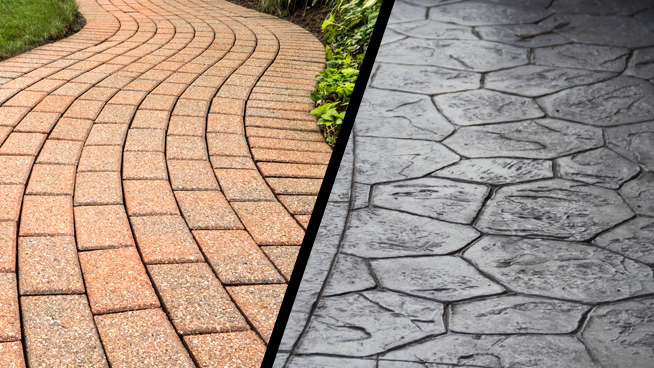
From The Detroit News | By Ken Calverley and Chuck Breidenstein
DETROIT, May 9, 2024 ~ Brick pavers and decorative concrete have been popular choices for paving projects in Michigan for many years.
They both offer unique benefits and can enhance the appearance of pathways, porches, patios, pool decks and driveways.
Concrete salesmen often argue that reinforced concrete is a superior choice as it provides a solid and durable surface. On the other hand, brick paver salesmen claim that decorative concrete is prone to cracking and fading over time.
In reality, both options have their own advantages and maintenance considerations.
Brick pavers come in a variety of colors and shapes and can be installed in numerous patterns, from herringbone to alternating rows to random shapes.
PODCAST:
May 12, 2024 ~ Chuck “The Inside Guy” Breidenstein and Ken “The Outside Guy” Calverly offer the knowledge and resources you need to make the home of your dreams a reality.
(CONTINUED)
They offer a textured surface that blends easily with surrounding plantings, are well-drained and can even support the growth of mosses and grasses in the joints surrounding individual pieces.
When undertaking a brick paving project, it is crucial to focus on what lies beneath the surface. Proper base preparation is vital for long-term stability and performance.
In southeast Michigan, where clay soil is prevalent and drainage can be a challenge, it is recommended to excavate the area at least 12 inches below grade. This allows for the installation of a drainage layer consisting of clean stone and sand, which is mechanically compacted to create a firm base for brick pavers.
If the property has a naturally drainable soil such as sand, a thinner base may be sufficient for brick pavers.
Another benefit to pavers is that if a single piece cracks or breaks, it can be replaced with relative ease to preserve the visual integrity of the project.
It is also important to install a type of border for pavers that will keep them in place.
There are heavy plastic and metal products that can be used for this purpose available where you purchase the paver product.
Decorative concrete typically has a texture and color applied to the surface.
Textures can vary from random shapes to “split-face” patterns that mimic natural stone features.
Some patterns may be deep enough to cause concern when plowing or shoveling snow, so it is advisable to discuss this with your installing professional on the front end.
How the various colors are applied is also of concern since some require more long-term care than others.
It is generally advised to stick with lighter, neutral shades for this reason.
Decorative concrete typically uses a minimum 4-inch crushed recycled concrete base thoroughly compacted with a mechanical tamper.
Steel rods or woven wire mesh should be incorporated to enhance its structural integrity. The professionally placed steel can prevent separation and vertical displacement when freeze/thaw action might otherwise move the slabs.
As discussed in earlier articles, such projects should always be installed such that they are well-drained.
Additionally, it is advisable to take note of the sealer used by the contractor and inquire about where it can be obtained.
Caution is advised over time if the original sealer is not available.
The existing sealer may need to be removed using chemical strippers before resealing.
Both brick pavers and decorative concrete will require maintenance after several years.
Brick pavers may experience issues with borders shifting and weeds growing between the bricks, while decorative concrete may develop hairline cracks and fade in color.
However, both can be maintained to near their original appearance with professional techniques employed by companies like Just Ask Home Maintenance.
For brick pavers, the process typically involves power washing to remove dirt and debris. Loose or shifted bricks can be reset and leveled, and the joints can be filled with polymeric sand to enhance stability.
When it comes to decorative concrete, power washing is also essential, and antiquing techniques can be employed to restore or enhance the color. Even if concrete pieces are missing, modern technologies may allow for effective patching and concealment.
Both brick pavers and decorative concrete are excellent choices for paving projects, provided they are specified and installed correctly.
It is crucial not to base purchasing decisions solely on price, as proper installation and maintenance are key factors in ensuring the longevity and aesthetic appeal of the chosen option.
If you are going to have it done, use one of the professionals you can find every day at InsideOutsideGuys.com and enjoy it for years to come!
**
For more advice, listen to “The Inside Outside Guys” every Saturday and Sunday on 760 WJR from 10 a.m. to noon or contact them at InsideOutsideGuys.com.
96.3 WDVD TOP STORIES:








